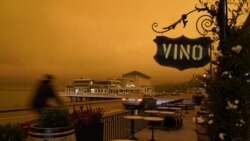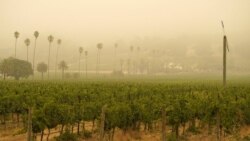Smoke from wildfires burning in the western United States has changed the taste of grapes in some of the country’s most celebrated vineyards. It has given the fruits a taste that could mean disaster for the 2020 harvest season.
Wineries in California, Oregon and Washington have survived wildfires before. But the smoke from the fires this year has been especially bad. It has been thick enough to cover whole vineyards. Day after day, some West Coast cities had some of the worst air quality in the world.
No one yet knows the severity of the smoke damage to the crop, but growers are trying to study it. If these grapes are made into wine without steps to limit the harm, the taste could be so bad that the product cannot be marketed.
The wildfires will likely be “without question the single worst disaster the wine-grape growing community has ever faced,” said John Aguirre. He is president of the California Association of Winegrape Growers.
Winemakers around the world are already adapting to climate change. That includes higher temperatures and longer periods with little or no rainfall. Vineyards near some forests face an added risk: the smoke from wildfires could ruin everything.
“Unfortunately, climate experts are telling us this is going to be a problem,” said Anita Oberholster, a wine expert at the University of California, Davis. “And so, we need to do better. We need to do loads more research.”
West Coast vineyards have already begun harvesting their crops. Yet some wineries are not taking grapes they had agreed to buy unless they have been tested for smoke damage, Aguirre said. Even worse, laboratories are too busy to test new orders in time.
ETS Laboratories has offices in the Napa Valley town of Saint Helena, California. The lab says test results on grape samples that it gets now will not be ready until November. Any samples after that will have to wait even longer, the lab’s website says.
Noah Dorrance owns Reeve Wines in Healdsburg, California. He talked to The San Francisco Chronicle newspaper about this year’s crop. In every grape he has tried, he said, “you could already taste and smell this ashy, barbecued” taste. It is similar to food cooked over a campfire, he said.
John Aguirre remembered trying the smoke-damaged wine during a tasting event. He read a comment that someone had written on a piece of paper. It compared the flavor to “fecal plastic.”
“I tasted it and I went, ‘Oh, my God,’” Aguirre said.
The issue comes from chemical compounds called volatile phenols. Those chemicals are naturally present in grapes. But burning wood releases them, and grapes can take in volatile phenols, Oberholster explained. When their levels get too high, it can make grapes taste unpleasant.
Australian researchers were the first to identify the risks. In 2003, they linked smoke in the atmosphere to a strange taste in wine, said Mark Krstic. He is managing director of the Australian Wine Research Institute. From then until 2015, Australian producers lost more than $286 million in grapes and wine profits as a result of smoke.
The problems continue. Australia’s most recent fire season was horrific, Krstic said. Fires were burning along Australia’s eastern coast and the smoke reached across crops from many vineyards, he said.
In the forested hills near Oregon’s Willamette Valley, fire covered the area with thick yellow-black smoke. The area is famous for its cool-climate pinot noir grapes and wines.
Jim Bernau is founder of Willamette Valley Vineyards. He said that in 38 years, he has “never experienced or seen anything like this as a wine grower.”
By last weekend, rain and changing winds had cleared the skies in Oregon. Bernau believed many Oregon wineries would escape damage because the smoke did not stay too long in the area.
His winery has been fermenting small samples to test whether smoke affects the resulting wine.
After just about two days, the results showed a low risk of smoke damage for the white and rosé wines. But for those, the skin is removed.
In fermenting red samples, the skin stays on. The first results are also hopeful. But the winery is ready to turn some of the grapes with heavier smoke damage into rosé instead of red wine, said Christine Clair. She is winery director at Willamette Valley Vineyards.
This month, Aguirre’s group and nine other industry organizations asked the U.S. Congress for disaster aid. They said without it their members will face economic unknowns at a level never before seen.
The wine industry had already suffered this year because of the coronavirus health crisis. Eateries, wine tasting rooms and other places had been shut down as a result.
But the West Coast’s “wildfire wines” might not be so bad.
In 2018, a California company quickly canceled deals to buy grapes worth millions of dollars from southern Oregon vineyards. The company claimed it feared the grapes were damaged by wildfire smoke. Four Oregon wineries stepped in, bought the grapes and produced “Oregon Solidarity” wines.
Those wines received praise from locals and wine critics.
I’m Alice Bryant.
The Associated Press reported this story. Alice Bryant adapted it for VOA Learning English. George Grow was the editor.
_______________________________________________________________
Words in This Story
grape - n. a green, dark red, or purplish-black berry that is used to make wine or is eaten as a fruit
vineyard - n. a field where grapes are grown
winery - n. a place where wine is made
adapt - v. to change something so that it functions better
sample - n. a small amount of something that is tested or given to people to try
barbecued - adj. like food that is cooked on a flat metal frame over hot coals or an open fire
fecal - adj. of or from solid waste that is released by the body
manage - v. to have control of something, such as a business, department or sports team
ferment - v. to go through a chemical change that results in the production of alcohol










